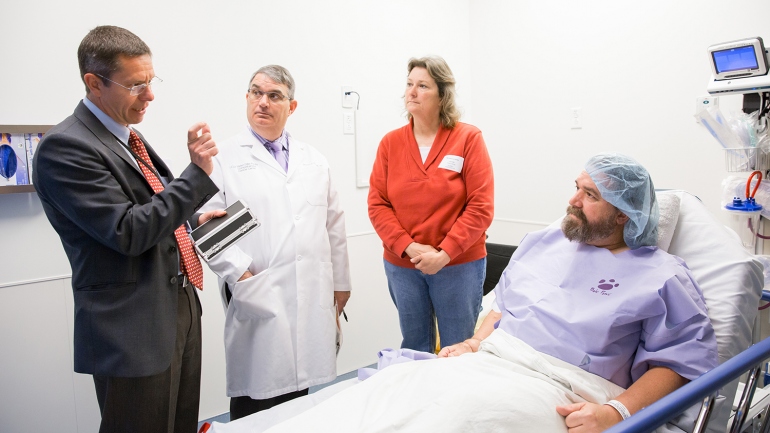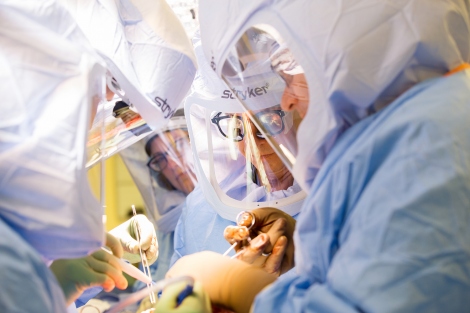Osseointegration Surgery at UCSF is First of Its Kind in U.S.
Unique Program Gives Amputees New Hope for Better Prosthesis

Having lost most of his right leg due to a rare nerve tumor, George Kocelj tried several external prostheses without success. For the 54-year-old from Marysville, Calif., the sockets proved to be unworkable, largely confining him to a wheelchair.
Overseeing Kocelj’s tumor treatment was Richard J. O’Donnell, MD, professor of clinical orthopaedic surgery and chief of the Orthopaedic Oncology Service at UCSF Medical Center. Seeing the challenges with a standard device, O’Donnell suggested a revolutionary approach – the Osseoanchored Prosthesis for the Rehabilitation of Amputees (OPRA).
Part of the field more broadly known as osseointegration, the OPRA implant is an alternative to traditional sockets in that the external prosthesis is anchored directly to the patient’s remaining bone through a permanently implanted titanium screw that comes through the skin. Therefore, the prosthesis always attaches correctly, remains firmly in place, and is free from pressure sores, pain, heat, chafing and general discomfort found with traditional solutions.
UCSF First in US to Proceed with OPRA Program
UCSF is the first U.S. center to proceed with an OPRA program, which was developed by Rickard Brånemark, MD, PhD, MSc, a visiting associate professor of orthopaedic surgery. Recruited to UCSF from Sweden for a two-year appointment, Brånemark has extensive expertise in osseointegration, having led studies on these percutaneous titanium implants for amputee patients for more than 25 years. Although the technology has been available in several other countries, this is the first patient to be treated since the device was approved by the U.S. Food and Drug Administration last July.

Osseointegration was pioneered by Brånemark’s late father, Per-Ingvar Brånemark, who first discovered in the 1950s that bone can integrate with titanium components. The technology has been used to anchor dental implants, helping millions of patients worldwide. Rickard Brånemark has established centers for amputee care throughout Europe, Asia, Australia and South America.
OPRA is installed with two surgical procedures. In the first, a cylinder-shaped fixture is implanted into the central canal of the remaining bone.
About six months later, after bone has grown to firmly secure the implant, the second operation places an abutment that extends through the skin, connecting to the external prosthesis.
The patient then works with a physical therapist to gradually place weight on the implant using a training prosthesis. About six months of rehabilitation is required, including fitting with a customized final prosthesis.
As the first recorded OPRA patient in the United States, Kocelj had his pioneering procedure performed on April 26 by O’Donnell, Brånemark and Rosanna L. Wustrack, MD, assistant professor of orthopaedic surgery. The second surgery is planned for fall 2016.
Working to Improve Patients' Lives
“I’m nervous, excited and overwhelmed,” Kocelj said before the surgery. “Just being able to walk and go is so exciting. It means a better quality of life. When this is all said and done, I want to be able to help other people out.”
Kocelj, who lost is leg above the knee due to neurofibromatosis, is the first surgical patient in the new UCSF international Center for Osseointegration Research, Education and Surgery (iCORES), co-directed by Brånemark and O’Donnell. The center, which has scheduled its second patient in late May, will offer the latest clinically available osseointegration treatment while creating a research environment to further expand function in patients with limb loss.
“UCSF has been at the forefront of developing osseointegration technology to save the limbs of cancer patients for four decades,” O’Donnell said. “However, when amputation is necessary, iCORES is now able to provide osseointegration techniques to these patients as well.”
The center also is collaborating closely with physicians at the Walter Reed National Military Medical Center on osseointegration opportunities. The Department of Defense Osseointegration Program, directed by Cmdr. Jonathan A. Forsberg, MD, PhD, is spearheading efforts at UCSF and nationwide to make the technology available not only to active duty military and veterans with combat-related injuries but also to patients like Kocelj, who have limb loss secondary to tumors or civilian trauma.